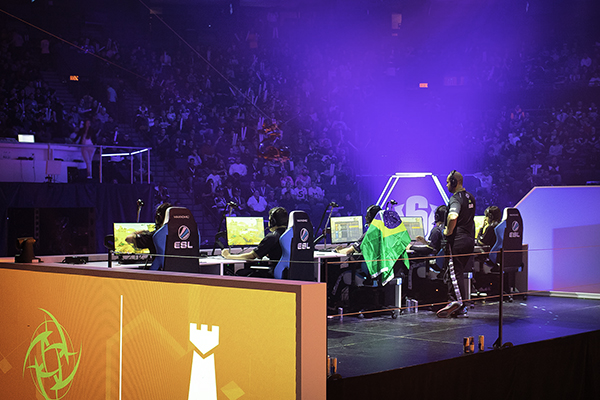BY Esther Haguenauer & Thomas-Loucas Voltzenlogel
Lucas Lasserre-Pellerin, 19, spends over ten hours a day playing video games. He’s aware of the fact that he’s addicted to his screens, but doesn’t believe he needs help.
“I know that anytime I’m anywhere, I’m going to be looking at my phone and playing video games. But I also know that I’d rather hang out with my friends than play all night,” he says.
“It’s a little worrying is that [Lucas] spends a lot of time in front screens, but at least he still goes out with friends and takes time to have a life,” says Cendrine Lasserre-Pellerin, Lucas’ mom.
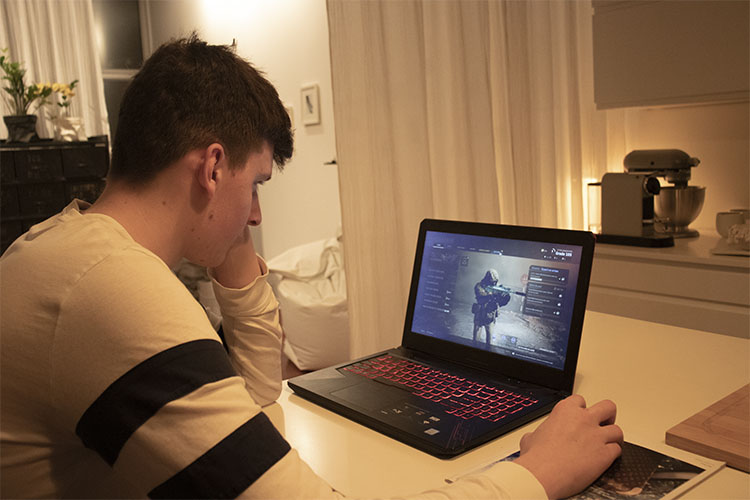
Lucas Lasserre-Pellerin plays Call of Duty on his computer, in Montreal, on Wednesday, February 5, 2020. Despite the fact that the game tends to anger him, he says that it’s part of the game and still loves it. Photo by Esther Haguenauer.
In 2018, the World Health Organization recognized gaming addiction as a mental health condition. For someone to be diagnosed with a “gaming disorder,” the time spent on screens has to have an impact on a person’s eating habits, social life and education.
The video game industry continues to grow in Montreal, with the city now hosting international gaming competitions. So it’s only logical that interest in gaming would grow as well.
According to a UQAM study, Montreal teenagers between the age of 15 and 17 that have asked for help spend about 55 hours a week in front of screens. The study defines a healthy amount of time as a maximum of 20 hours a week.
The same study found that about 21 percent of sixth graders spend over four hours a day playing video games for recreational purposes only.
According to Carolanne Campeau, social campaign coordinator at cyber-dependence awareness initiative PAUSE, four hours is excessive. They say that the amount of time young children spend in front of screens correlates with the quality of life.
“The more time these kids spend in front of screens, the higher stress and anxiety levels and the lower performance at school they experience,” says Campeau.
Michael Stora is a psychologist who does research and works in gaming dependence. He says that over 95 per cent of the teenagers he treats are kids who have high IQs, but that a trauma in their life, especially academic failure, is likely to make them fall into a gaming addiction.
“Video games and rankings are what will give them a cause, a way to keep being great at something,” says Stora.
Another study done by Miguel Therriault, a clinician and researcher at the Le Grand Chemin treatment center, found that one in five teenagers in Quebec is at risk of cyber-dependence, and that number is rising.
According to Campeau, the problem is that the issue of screen addiction is fairly new, meaning that not a lot of research has been done on the topic.
She says that the main method used to deal with it so far is interventions like the ones done for gambling addictions. Unlike substance use, gaming and gambling trigger hormone releases like dopamine which makes one want to keep going.
“Developers for example, will develop games in ways that the colours and sound will trigger hormones that make gamers want to play over and over and stay online as long as possible,” says Campeau.
Pro-gaming is getting bigger in Montreal and around the world. Big events taking place in the city and e-sport curriculums opening are opening doors for aspiring pro-players. Video by Thomas Voltzenlogel
Campeau adds that big gaming companies seem to be taking a page out of casinos’ books when it comes to keeping gamers playing.
According to Stefan Jovanovic, who teaches video game culture at Concordia University, video games have always been designed to have a constant inflow of gamers.
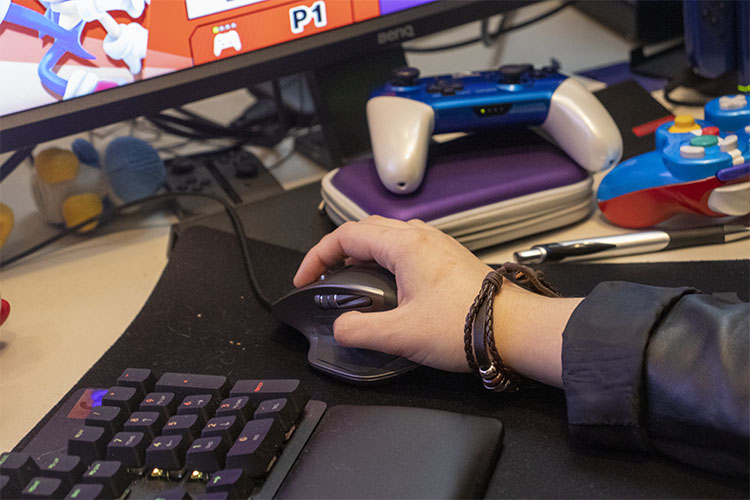
Kelsy Medeiros plays Super Smash Bros on her Nintendo Switch, on Bizard Island, on Sunday, February 9, 2020. She’s been playing this game since 1999. Photo by Esther Haguenauer.
Back in the 70s and 80s, this meant infusing gaming with arcades that encouraged gamers to show up where the consoles were. Now, with access to wireless gaming, the industry has focused on promoting multiplayer games to mimic that social setting but with the convenience of staying at home.
“The stakes now are a bit different […] now it’s about monetizing your possible data and keeping track of all aspects of the gameplay,” says Jovanovic.
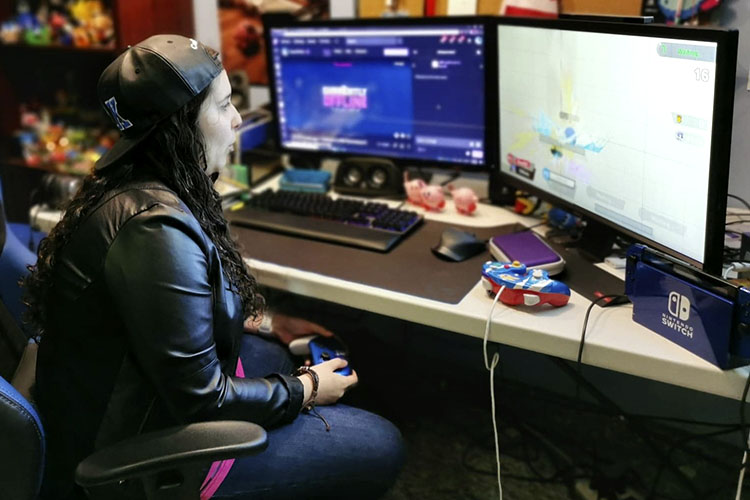
Kelsy Medeiros plays Super Smash Bros on her Nintendo Switch, on Bizard Island, on Sunday, February 9, 2020. Her all-time favourite character is Sonic the Hedgehog because he’s so quick. Photo by Esther Haguenauer.
With multiple platforms – computers, phones, consoles – gamers have the possibility to keep playing at all times of the day, whenever they have access to games on their phone. That means a greater risk of dependence.
Stora says that the games that are most likely to cause dependence are those like Fortnite that involve direct competition, as opposed to simulation games, like The Sims, where the purpose is to construct communities or worlds.
“What they’re addicted to, more than anything is winning,” says Stora.
Gaming addiction affects the hippocampus in the brain, causing a lack of orientation and loss of memory. There have been correlations with psychiatric illnesses such as depression.
However, Stora thinks that society is uninformed, and uses the term “gaming addiction” too lightly. He says a lot of people label anyone who spends some amount of time every day playing video games as an “addict.”
“This new pathology has become trendy, which unfortunately means that many of the kids I’ve treated had been wrongfully sent to rehab and treatment facilities,” says Stora.
Another big concern voiced by WHO is that while screens have positive aspects, their use requires limitations and structure to limit the risks. Usually, professional gamers are aware of the possible harms of cyber-dependence, but children and teenagers are particularly susceptible to becoming addicted.
However, Montreal is hosting more and more big video game events, and opening gaming curriculum and academies dedicated to e-sports. That raises concern from parents who think these events encourage young people to play as much as they want, as long as the goal is to become a professional gamer.
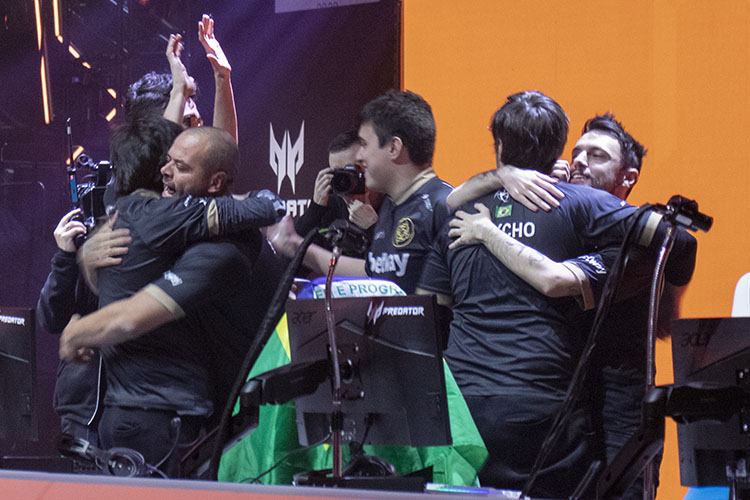
Team Ninjas in Pyjamas celebrates as they win their game, advancing to the semi-finals during the Six Invitational, in Laval on Saturday, February 15, 2020. Photo by Esther Haguenauer.
Campeau says e-sport academies are actually well-structured and give a healthy idea of what gaming should be to the players. She says spotting the signs of cyber addiction are part of the curriculum. However, it also sends out an image to other youth that there is no danger to playing games for hours on end.
She says that another big issue is that the majority of students who are gaming are not necessarily in specific academies like that or in specific programs like that. So, they’re not being structured in that way and their parents are not necessarily getting the information that they need to structure it at home.
“I’m aware that spending so much time in front of screens isn’t the best to maintain good family relationships but even though I always try to finish my game, I also make sure to never miss meals,” says Lucas Lasserre-Pellerin.
He has no interest in going pro and says he only spends hours playing games when he’s bored.
His mom believes that when he spends more than five hours a day gaming, it becomes a real problem. Lucas says that he agrees that he plays too much, but he isn’t that concerned about it because he’s certain he can handle it.
Test your gaming addiction knowledge. Quiz by Thomas-Loucas Voltzenlogel and Esther Haguenauer.
